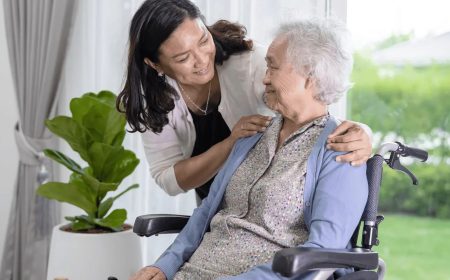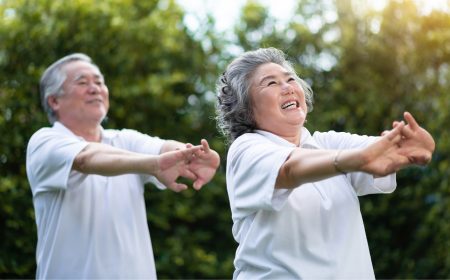If you have just undergone hip surgery, this article is designed to provide you with general advice on how to manage at home after the surgery and guidance on home exercises to help you regain strength.
It is important to exercise after a hip replacement surgery to restore normal movement in your joints. This will help to build up strength in the joints and surrounding muscles, ease pain and swelling and help with circulation, especially right after surgery, to prevent blood clots from forming in the veins. Ultimately, exercising will help you get back to your normal activities.
General Precautions for Hips

Do not bend your operated hip beyond 90 degrees.
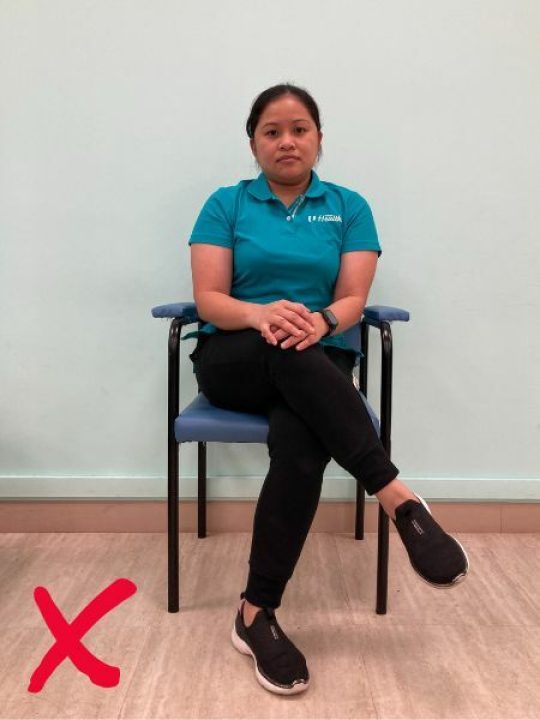
Do not cross your operated leg or ankle over the other leg.
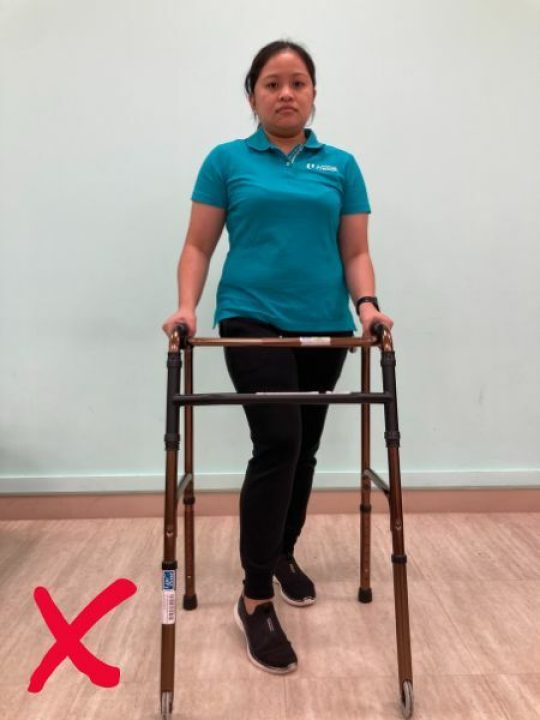
Do not turn your operated leg inward in a pigeon-toed position.
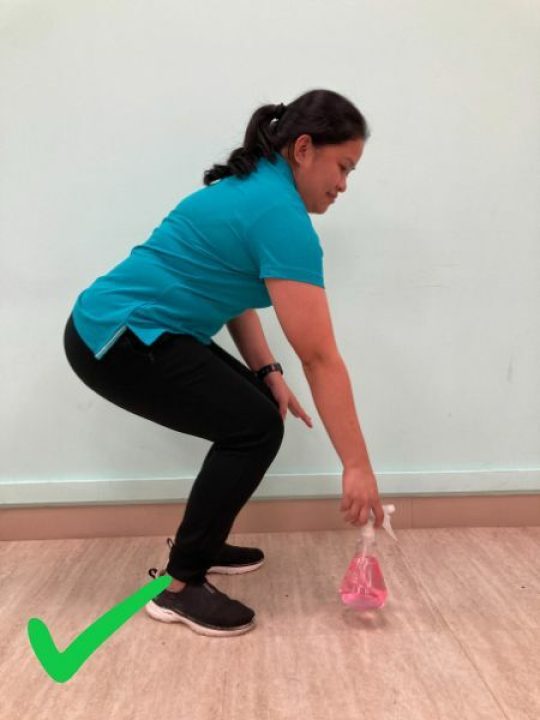
If you need to pick up an item from the floor after the initial recovery period, you may be able to do so in a modified manner. However, do check with your surgeon/therapist first.
Some pain in the initial period is common as you heal
You may take your pain medicine as instructed by your surgeon. Do speak to him/her if you need more medications.
Alternatively, you may use a cold pack if the wound area is painful or warm to touch. Apply the cold pack to the affected area for 15 to 20 minutes each time. You may do this 3 to 4 times per day, or after you have done your exercises.
Perform the exercises as prescribed by your therapist
If you have any questions regarding these exercises, please check with your therapist before working on the exercises.
1. Stretching Exercises
Front Thigh Stretch
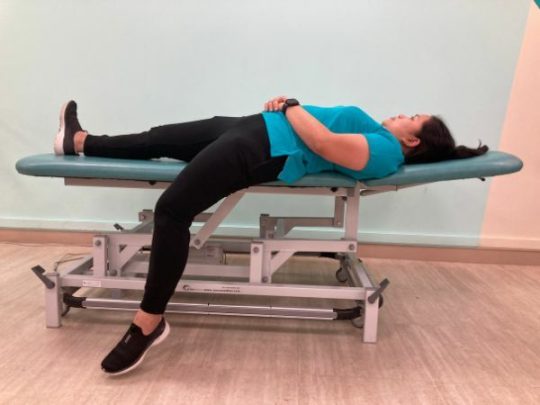
Start this exercise only when your muscles and wound have healed well and when you feel more confident with the hip motion. If you are unsure, please check with your therapist before doing this exercise.
- Lie on the edge of your bed.
- Gently lower your leg over the edge of the bed.
- If the bed is too high and you are unable to touch the floor with your foot, you may use a small stool/thick book to support your leg.
- Hold the stretch for 2 to 3 minutes.
- You may repeat this on the other side.
2. Range of Motion Exercises
Hip Flexion
To improve motion of the hip joint after surgery
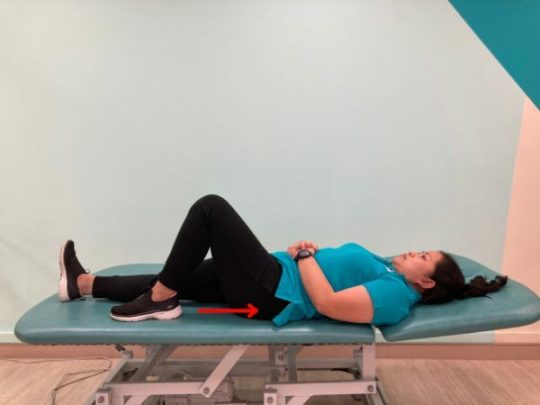
- Lie on your bed or on a firm surface.
- Gently slide the heel of the operated leg up towards your buttock.
- Keep your knee pointed up.
- Do not overstretch.
- Hold for 10 seconds, and repeat for 5 to 10 times.
- You may repeat this on the other side.
Hip Abduction
To improve motion of the hip joint after surgery

- Lie on your bed or on a firm surface.
- Gently slide the heel of the operated leg outwards.
- Keep your knee pointed up.
- Do not overstretch.
- Hold for 10 seconds, and repeat for 5 to 10 times.
- You may repeat this on the other side.
3. Strengthening Exercise
Bridging
To strengthen the buttocks and lower back muscles
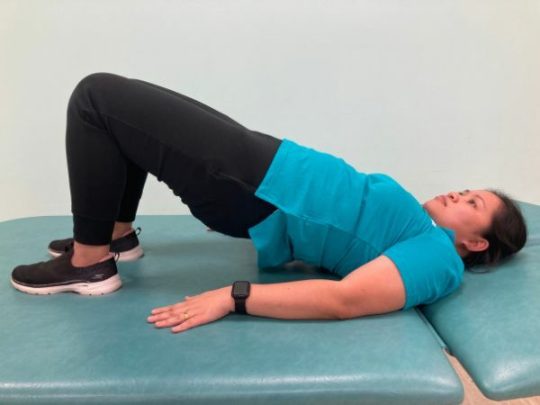
- Lie on your bed or on a firm surface. Bend both knees.
- Slowly raise your hips by pushing through your heels.
- Your hips should be in line with your trunk and knees.
- Hold for 10 seconds and repeat for 10 times.
- You may do 2 to 3 sets.
Leg Raise (Front)
To strengthen the inner thigh muscles

- Lie on your bed or on a firm surface. Bend the knee of your non-operated leg.
- Straighten and slowly raise the other leg by about 10 inches off the bed.
- Hold for 10 seconds and repeat for 10 times.
- You may do 2 to 3 sets and repeat on the other side.
Note: It is normal to feel an ache or slight pain over the groin area. It will get better as you get stronger.
An ankle weight may be added for more resistance as you improve.
Leg Raise (Side)
To strengthen the outer hip muscles
Note: An ankle weight may be added for more resistance as you improve
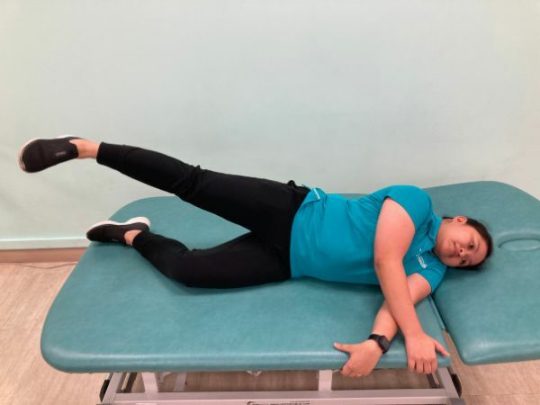
- Lie on the side of your bed or on a firm surface, with a pillow/cushion between your legs.
- Straighten and slowly raise the operated leg by about 10 inches off the bed.
- Hold for 10 seconds and repeat for 10 times.
- You may perform 2 to 3 sets, and repeat this on the other side.
Clam Shell
To strengthen the outer hip muscles
Note: A resistance band may be tied around the knees for more resistance as you improve

- Lie on the side of your bed or on a firm surface, with a pillow/cushion between your knees.
- Keep your heels together.
- Gently press your heels together and raise your upper leg.
- Keep your pelvis/trunk facing forward at all times to avoid turning at the pelvis.
- Hold for 10 seconds and repeat for 10 times.
- You may perform 2 to 3 sets, and repeat this on the other side.
Half Squat
To strengthen your buttocks and thigh muscles

- Stand in front of a chair. Keep your legs slightly apart with your toes pointing forward.
- Slowly lower your buttocks onto the chair, just before they touch the edge of chair.
- Hold for 5 to 10 seconds.
- Slowly return to standing position.
- Repeat for 10 times.
- You may do 2 to 3 sets.
Hip Abduction (Standing)
Note: An ankle weight or a resistance band may be added for more resistance as you improve
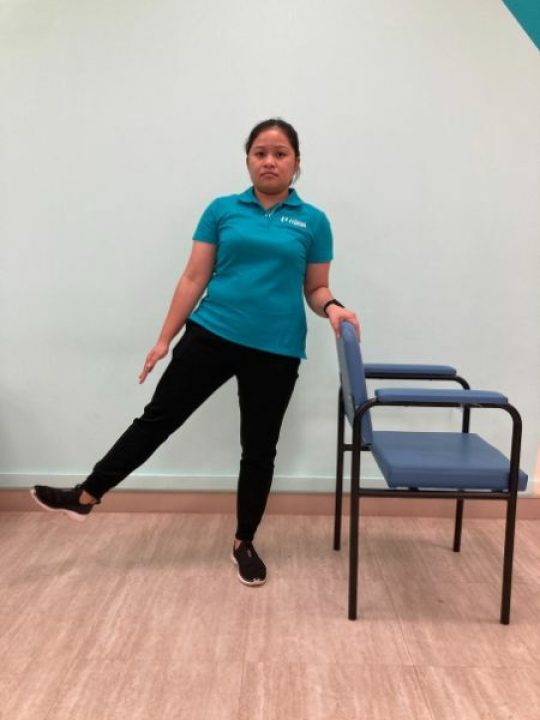
- Stand with your feet slightly apart.
- Slowly raise your operated leg to the side.
- Keep your toes pointing forward.
- Hold for 10 seconds and repeat for 10 times.
- You may perform 2 to 3 sets, and repeat on the other side.
Hip Extension (Standing)
To strengthen the buttock muscles
Note: An ankle weight or a resistance band may added for more resistance as you improve

- Stand straight behind a chair.
- Slowly lift your operated leg to the back.
- Keep your back straight, and toes forward.
- Hold for 10 seconds and repeat for 10 times.
- You may perform 2 to 3 sets, and repeat this on the other side.
Standing Hamstring Curl
To strengthen the muscles at the back of the thighs
Note: An ankle weight may be added for more resistance as you improve

- Stand straight behind a chair.
- Slowly bend the knee of your operated leg, as though you are trying to touch your buttock with your heel.
- Keep your back straight.
- Hold for 10 seconds and repeat for 10 times.
- You may repeat this on the other side.
Heel Raise
To strengthen the calf muscles
Note: You may progress to single heel raise as you get stronger

- Stand straight behind a chair.
- Slowly raise both heels as high as you can.
- Hold for 10 seconds and repeat for 10 times.
- You may perform 2 to 3 sets, and repeat this on the other side.
Managing Activities of Daily Living
Please consult your therapist if you have any doubts on the following activities.
- Walking and cycling may be good forms of aerobic exercise for you.
- You may start to walk short distance with a walking aid in the first 2 weeks after the surgery and progress to walking independently after 2 to 3 weeks. Some clients may take a longer time to wean off the walking aid, do check in with your therapist on this.
- In general, the recommended walking duration is:
- Week 1 and 2: 2 to 3 times per day, 5 to 10 minutes each time.
You may be using a walking aid at this stage. - Week 3 onwards: Increase the distance by 10% each week (I.e if you used to walk 20 metres,
increase it to 22 metres). You may seek advice from your therapist to check if you are able to do so without a walking aid.
- Week 1 and 2: 2 to 3 times per day, 5 to 10 minutes each time.
- Your therapist may also put you on a recumbent bicycle for cardiovascular exercise after the first few weeks depending on your rate of recovery.
Getting Out of Bed

Step 1: Try to get out of the bed on the same side as your operated leg.
Step 2: Prop yourself up on your elbows and hands to get into a long sitting position (with legs in front).
Step 3: Move to the edge of the bed with the help of your non-operated leg and arms. Do not twist or cross your operated leg over your non-operated leg.
Step 4: Swivel and sit on the edge of the bed, while keeping your operated leg straight.
Step 5: Sit with your feet on the floor.
Transferring from Wheelchair to Another Chair/Bed
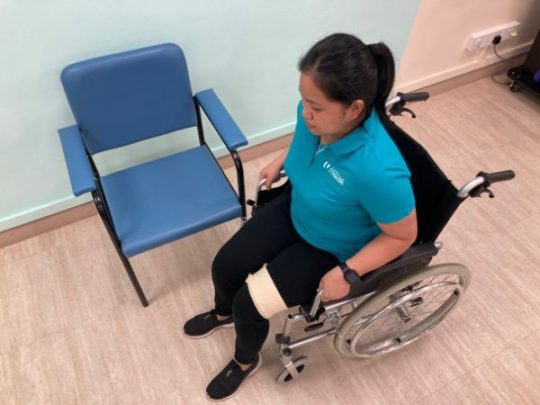
Step 1: Position the wheelchair next to the non-operated leg. Lock the wheelchair and move the foot and arm rest out of the way (if necessary).

Step 2: Shift to the edge of the wheelchair so that both of your feet are resting on the floor.
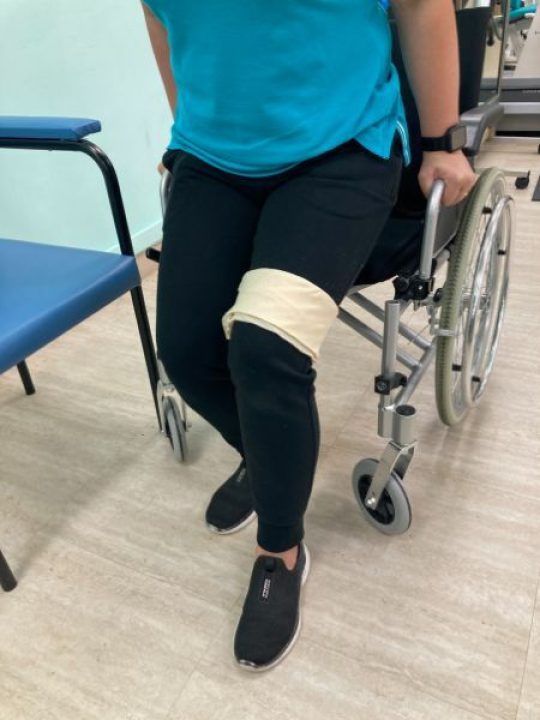
Step 3: Position the operated leg slightly forward.
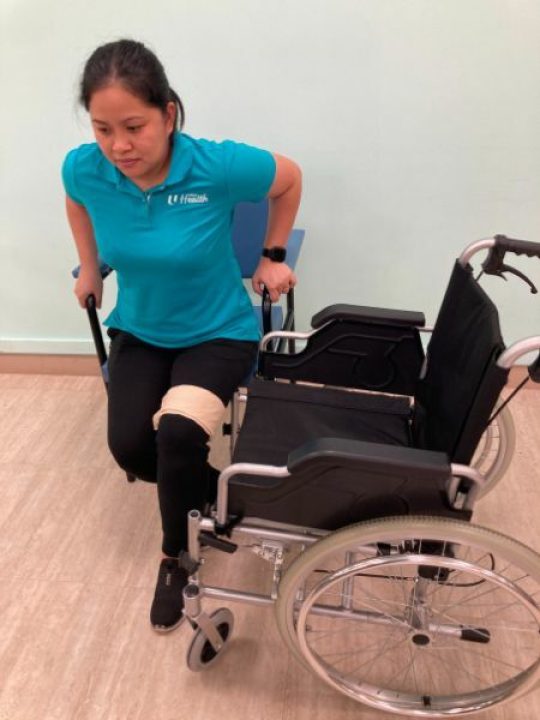
Step 4: Push yourself up from the wheelchair and take a step towards the chair. Hold onto the arm rest. Slowly lower yourself down onto
the chair.
Using a Walking Stick / Quad Stick
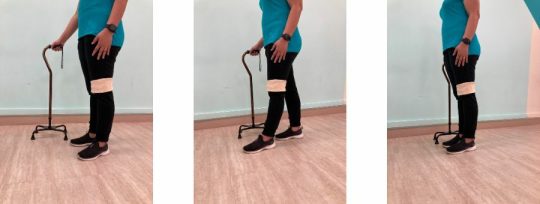
Step 1: Hold the stick at the side of your non-operated leg. Place the stick slightly in front of your feet. If you are using a quadstick, ensure all four legs of the quadstick are in contact with the ground.
Step 2: Step forward with the operated leg such that it is aligned with the stick. Gently press down onto the stick with your hand for stability and support as you step forward.
Step 3: Step forward with the non-operated leg to align with the other foot. Repeat the process.
Using a Walking Frame
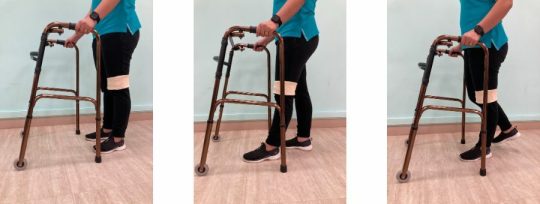
Step 1: Place the walking frame slightly in front of your feet. Be sure that all four legs of the frame are in contact with the ground.
Step 2: Step forward with the operated leg. Keep the foot within the frame. Avoid stepping too close to the front of the frame.
Step 3: Step forward with the non-operated leg to align with the other foot. Repeat the process.
Climbing the Stairs
Up the stairs
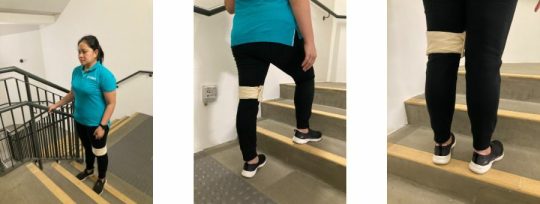
Step 1: Place your hand on the handrail.
Step 2: Step up with the non-operated leg. If you are using a stick/quadstick, it should be placed on the same step as your operated leg. You may press lightly on the stick for support as you go up the stairs.
Step 3: Step up with the operated leg, and bring up the stick if you are using one.
Down the stairs

Step 1: Place your hand on the handrail.
Step 2: Step down with the operated leg. If you are using a stick/quadstick, place the stick on the step below.
Step 3: Step down with the non-operated leg.
Use of Assistive Devices to Help With Daily Activities
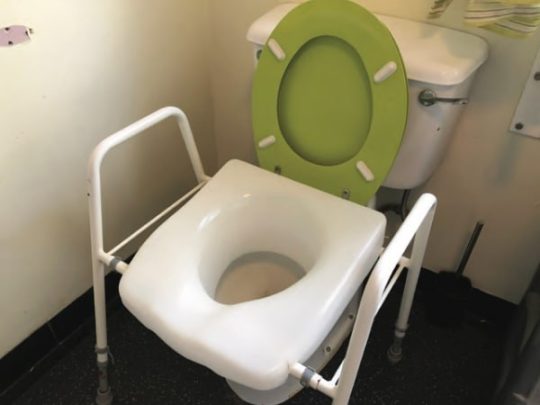
Install a raised toilet seat to help in sitting and standing

Use a long handle bath sponge to help in showering

Use a shoe horn to help you put on slip-on shoes easily

Use a long handle reacher to assist in wearing of pants
Need help with recovery?
If you or your loved one has recently had a hip fracture or hip replacement surgery and in need of professional and dedicated help with the recovery process, visit our Rehabilitation and Physiotherapy page to learn more about NTUC Health’s Day Rehab and Home Therapy care services.

